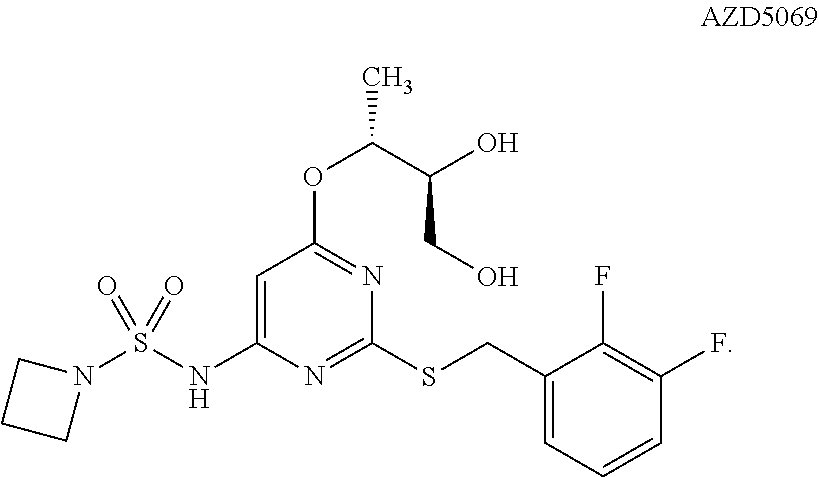Therapeutic combinations and methods for treating neoplasia
a technology of neoplasia and combination therapy, applied in the field of combination therapy and treatment of neoplasia, can solve the problems of unmet needs, cancer continues to be a major global health burden, and tumor-specific t-cell responses are difficult to mount and sustain in cancer patients
- Summary
- Abstract
- Description
- Claims
- Application Information
AI Technical Summary
Benefits of technology
Problems solved by technology
Method used
Image
Examples
example 1
r Effects of CXCR2 Antagonist in Combination with Checkpoint Inhibitors
[0096]To test the hypothesis that a CXCR2 antagonist may potentiate anti-tumor effects of immunomodulatory agents, tumor-bearing Balb / C mice are dosed with varying doses of CXCR2 alone and in combination with mouse anti-PD-L1 and anti-CTLA-4 antibodies in a preventative anti-tumor study.
[0097]Mouse syngenic tumor cells are grown with RPMI supplemented with 10% fetal bovine serum. Cells are grown in monolayer culture, harvested by trypsinizatin, and implanted subcutaneously into the right flank of 6-8 week old female Balb / C (CT26), C57 / B16 (MCA205), or 4-6 week athymic female nude mice (Harlan, Indianapolis, Ind.). For the mouse tumor model, 5×105 cells are implanted in the right flank using a 27-gauge needle. Antibodies including Anti-PD-L1, anti-CTLA-4, and mouse IgG2b control; and Rat IgG2a isotype control antibodies are produced by MedImmune (Gaithersburg, Md.). Antibodies are dosed via intraperitoneal injecti...
example 2
r Effects of AZD5069 and MEDI4736
[0098]Subjects in this study are required to be 18 years of age or older with advanced malignant melanoma, renal cell carcinoma (RCC), non-small cell lung cancer (NSCLC), or colorectal cancer (CRC) refractory to standard therapy or for which no standard therapy exists. Subjects in the dose-expansion phase of the study will be adults with advanced malignant melanoma, NSCLC, or CRC refractory to standard therapy or for which no standard therapy exists. Additional subjects in the dose-expansion phase had NSCLC (Squamous cell carcinoma), hepatocellular cancer (HCC), triple-negative breast cancer (TNBC), pancreatic cancer, GI cancer, melanoma, uveal melanoma, or Squamous cell carcinoma of the head and neck (SCCHN). The cancers must be histologically- or cytologically confirmed. The subjects are required to have an Eastern Cooperative Oncology Group (ECOG) status of 0 or 1 as well as adequate organ and marrow function. Adequate organ and marrow function is...
PUM
 Login to View More
Login to View More Abstract
Description
Claims
Application Information
 Login to View More
Login to View More - R&D
- Intellectual Property
- Life Sciences
- Materials
- Tech Scout
- Unparalleled Data Quality
- Higher Quality Content
- 60% Fewer Hallucinations
Browse by: Latest US Patents, China's latest patents, Technical Efficacy Thesaurus, Application Domain, Technology Topic, Popular Technical Reports.
© 2025 PatSnap. All rights reserved.Legal|Privacy policy|Modern Slavery Act Transparency Statement|Sitemap|About US| Contact US: help@patsnap.com


